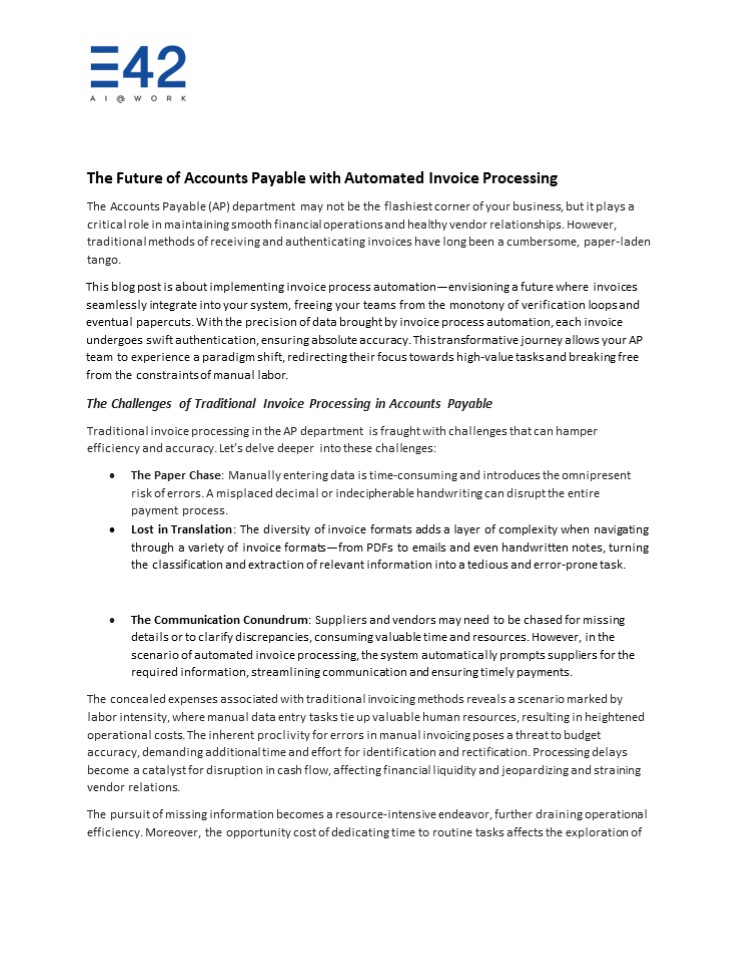The Future of Accounts Payable with Automated Invoice Processing PowerPoint PPT Presentation
Title: The Future of Accounts Payable with Automated Invoice Processing
1
- The Future of Accounts Payable with Automated
Invoice Processing - The Accounts Payable (AP) department may not be
the flashiest corner of your business, but it
plays a critical role in maintaining smooth
financial operations and healthy vendor
relationships. However, traditional methods of
receiving and authenticating invoices have long
been a cumbersome, paper-laden tango. - This blog post is about implementing invoice
process automationenvisioning a future where
invoices seamlessly integrate into your system,
freeing your teams from the monotony of
verification loops and eventual papercuts. With
the precision of data brought by invoice process
automation, each invoice undergoes swift
authentication, ensuring absolute accuracy. This
transformative journey allows your AP team to
experience a paradigm shift, redirecting their
focus towards high-value tasks and breaking free
from the constraints of manual labor. - The Challenges of Traditional Invoice Processing
in Accounts Payable - Traditional invoice processing in the AP
department is fraught with challenges that can
hamper - efficiency and accuracy. Lets delve deeper into
these challenges - The Paper Chase Manually entering data is
time-consuming and introduces the omnipresent
risk of errors. A misplaced decimal or
indecipherable handwriting can disrupt the entire
payment process. - Lost in Translation The diversity of invoice
formats adds a layer of complexity when
navigating through a variety of invoice
formatsfrom PDFs to emails and even handwritten
notes, turning the classification and extraction
of relevant information into a tedious and
error-prone task. - The Communication Conundrum Suppliers and
vendors may need to be chased for missing details
or to clarify discrepancies, consuming valuable
time and resources. However, in the scenario of
automated invoice processing, the system
automatically prompts suppliers for the required
information, streamlining communication and
ensuring timely payments. - The concealed expenses associated with
traditional invoicing methods reveals a scenario
marked by labor intensity, where manual data
entry tasks tie up valuable human resources,
resulting in heightened operational costs. The
inherent proclivity for errors in manual
invoicing poses a threat to budget accuracy,
demanding additional time and effort for
identification and rectification. Processing
delays become a catalyst for disruption in cash
flow, affecting financial liquidity and
jeopardizing and straining vendor relations. - The pursuit of missing information becomes a
resource-intensive endeavor, further draining
operational efficiency. Moreover, the opportunity
cost of dedicating time to routine tasks affects
the exploration of
2
innovative business practices, taking up valuable
resources that could otherwise be allocated to
high- value, strategic initiatives. A Technical
Deep Dive into Automated Invoice Processing The
traditional AP process, characterized by the
rustling of papers and manual data entry, is on
the brink of obsolescence. Automated invoicing
emerges as a facilitator, efficiently guiding
invoices through the stages of capture,
authentication, and processing. Implementing AI
for invoice process automation not only
streamlines operations but also effectively
resolves persistent issues that have historically
challenged the financial landscape. Invoice
Capture From Paper Jams to Seamless
Integration Gone are the days of paper mountains
and misplaced invoices. Automated invoice capture
effortlessly digitizes invoices from diverse
channelsemails, portals, and even handwritten
notes. This not only eliminates the risk of data
entry errors inherent in manual processes but
also tackles practical problems like lost
invoices, illegible handwriting, and inconsistent
formats. Automated invoice processing ensures all
information reaches the system, regardless of its
origin or presentation. Invoice Authentication
From Fraudulent Notes to Fort Knox
Security Authentication, the vigilant guardian in
the AP symphony, leverages advanced algorithms to
analyze captured data against purchase orders and
supplier information. Discrepancies are flagged
for human review, protecting businesses from
fraudulent activities. This crucial step
mitigates inefficiencies like duplicate invoices,
incorrect pricing, and supplier fraud. AI-powered
analysis identifies and eliminates fraudulent
attempts, safeguarding financial resources and
ensuring the legitimacy of every
transaction. Omnichannel Presence Building
Vendor Relationships on a Global
Stage Omnichannel capabilities foster a
harmonious relationship with vendors, allowing
them to submit invoices through their preferred
channels (email, portal, EDI). This not only
enhances convenience but also addresses issues
like communication gaps, supplier frustration,
and limited reach. Consistent and accessible
communication channels ensure prompt responses,
eliminate unnecessary back-and-forth exchanges,
and foster inclusivity with all vendors,
ultimately strengthening overall vendor
relations. Bringing in Straight-Through
Processing (STP) With AI Straight-through
processing (STP) with AI-led automated invoice
processing tranfroms the entire invoicing cycle
by creating a robust automated system that
seamlessly handles tasks from receipt to payment
without human intervention. Employing highly
trained AI algorithms, this system efficiently
extracts crucial data from invoices, including
vendor details, amounts, and payment deadlines,
with unparalleled accuracy. The integration of AI
streamlines validation and approval workflows,
facilitating swift and error-free processing
while significantly reducing the time and
resources traditionally required for invoice
management. This transformative approach not only
enhances operational efficiency but
3
also minimizes errors, resulting in substantial
cost savings and heightened financial
transparency for organizations. Conclusion Automat
ed invoice processing transcends mere
technological advancement it signifies a
transformative shift. In this seamlessly
integrated automated system, every aspectfrom
invoice capture and authentication to omnichannel
presence and STPworks harmoniously to create a
robust and secure AP framework. Acting as a
facilitator rather than a conductor, AI-led
automation addresses practical challenges,
strengthens vendor relationships, and delivers
unparalleled efficiency and accuracy. As
businesses adopt this technological evolution,
they can confidently position themselves on the
stage of financial excellence, shedding the
constraints imposed by traditional, manual
processes. To kickstart your finance automation
journey, write to us at interact_at_e42.ai!

